Bobalos
Well-known member
- May 5, 2021
- 6,718
- 5,308
I have wondered for years what the difference is between a V-Nose Trailer & a flat faced trailer. I've often heard the “V-nose is more stable”. I've also heard the “V-Nose is more streamlined & makes the mileage go up” and I've also heard “it don’t make no difference”. Like everything in life, I'm sure that there are quite a few factors that play into it, but there are likely some things that make up the majority of the factors. So I decided to do a test to see, if in my configuration, I could see a real world difference.
Background: 1993 Wells Cargo 24’ x 8.5’ x 10’ High (Tongue length 4' 8"). The trailer has a 11,200 GVW. I have owned the trailer since 2004. Semi-related to this, I also noticed that when we went from the VeeWee (1600 Lbs.) to the PSD (2600 Lbs.) that my mileage went down by quite a bit. I was getting 15 or 16 MPG with the VeeWee & 10 to 11 with the PSD. There was a good bit more than just the weight of the Buggy that goes with that. Jacks, loading tires, a LOT more fuel, air compressor, microwave, etc, etc…. I use my 1999 Dodge Ram 2500 to tow this with and have owned it since late 2000 or early 2001.
In Sept of 2016, I constructed the wedge out of ½”x½” square steel tubing and long piano hinges I got from Competitive Metal in El Cajon. Initially I made the skin of it, out of Coroplast, but after the sun tore that up, I switched to aluminum sheet. I made it so that I could collapse the wedge flush with the front of the trailer so I could do A-B-A testing to see if there is a significant difference in mileage & drivability with the wedge out or in. Each panel is 52” (W) x 59” (H). When “out” it is 92” wide @ the base on the trailer & extends forward 26”.
I started going out to the desert in 2012 with the VeeWee & changed from it to the PSD in Feb of 2018.
The Bottom line: There are other factors that make a more substantial difference in the mileage than having the wedge out or in. the most significant of those is weight and wind.
The Details: I drove all over southern Kalipornia with no wedge with a few different cars in it, and the truck has worked pretty hard all of the time. I'm sure part of that is that it’s a stock height 2x4 truck with an extra tall trailer. After I installed the Wedge I did alternating weekends with it out VS in and kept detailed notes on fuel consumption, total miles traveled, wind and rough notes on other things (kids, weekend lengths, traffic, locations, etc). I have an adjustable hitch with load leveling bars and a friction type anti-Sway device. I did not start using the anti-sway device until late 2018 or early 2019 when we were having a VERY windy trip going back home & I pulled over on the side of the road & put it onto the trailer. FWIW, I put it on every time now & only crank it down if its windy. I hate to admit that I lost all of the data I had collected in my mileage log in a computer crash. I had a beautiful (to some) spreadsheet that had all of the data in it……
· I found that there was no correlation between the Wedge out VS the Wedge in when it came to mileage.
· I did find that having the wedge out made it “a little more stable” @ speeds above 60 MPH.
· I also found that there is no real difference in mileage between 55 and 65 MPH (more on that later).
· I did find that when it was windy, the Friction Anti-Sway device made a very significant difference in the stability/drivability compared to the diverter.
Side note……. somewhere’s about 2001 or 2002 I bought a 66 Chevelle from a guy up in the bay area (500 Miles one way). A buddy of mine towed it with his early 90’s lowered crew cab dually with a 454. Of course I was paying for gas and we stopped every 10 minutes to put 30 gallons of regular in that thing (well not EVERY 10 minutes, but it felt like it). I calculated it was getting 10 MPG and the stupid trailer was EMPTY………….. how bad was it going to get when we put 3500 Lbs. of Chevelle into it…….. Guesses anyone??? The answer is 10 MPG. The truck/trailer did not care one little bit that the trailer now had a car in it. I never duplicated that test with my Dodge when I got it, but it was certainly interesting.
Here is the truck and trailer when I first bought the trailer.

The framework for the wedge.
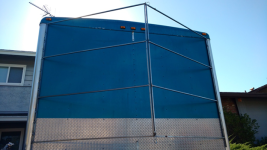

With Coroplast
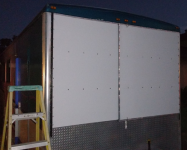
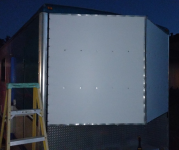
Painted Aluminum sheet, and you can see where the bugs hit the diverter. If you cant see it, its from the seam up to the top, which is about 2/3 the way up from the bottom. It kind of tells a story………
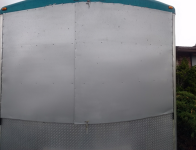
Weight of one side of the diverter. So in total it added about 35 Lbs. with the struts and hardware.
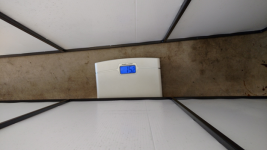
Background: 1993 Wells Cargo 24’ x 8.5’ x 10’ High (Tongue length 4' 8"). The trailer has a 11,200 GVW. I have owned the trailer since 2004. Semi-related to this, I also noticed that when we went from the VeeWee (1600 Lbs.) to the PSD (2600 Lbs.) that my mileage went down by quite a bit. I was getting 15 or 16 MPG with the VeeWee & 10 to 11 with the PSD. There was a good bit more than just the weight of the Buggy that goes with that. Jacks, loading tires, a LOT more fuel, air compressor, microwave, etc, etc…. I use my 1999 Dodge Ram 2500 to tow this with and have owned it since late 2000 or early 2001.
In Sept of 2016, I constructed the wedge out of ½”x½” square steel tubing and long piano hinges I got from Competitive Metal in El Cajon. Initially I made the skin of it, out of Coroplast, but after the sun tore that up, I switched to aluminum sheet. I made it so that I could collapse the wedge flush with the front of the trailer so I could do A-B-A testing to see if there is a significant difference in mileage & drivability with the wedge out or in. Each panel is 52” (W) x 59” (H). When “out” it is 92” wide @ the base on the trailer & extends forward 26”.
I started going out to the desert in 2012 with the VeeWee & changed from it to the PSD in Feb of 2018.
The Bottom line: There are other factors that make a more substantial difference in the mileage than having the wedge out or in. the most significant of those is weight and wind.
The Details: I drove all over southern Kalipornia with no wedge with a few different cars in it, and the truck has worked pretty hard all of the time. I'm sure part of that is that it’s a stock height 2x4 truck with an extra tall trailer. After I installed the Wedge I did alternating weekends with it out VS in and kept detailed notes on fuel consumption, total miles traveled, wind and rough notes on other things (kids, weekend lengths, traffic, locations, etc). I have an adjustable hitch with load leveling bars and a friction type anti-Sway device. I did not start using the anti-sway device until late 2018 or early 2019 when we were having a VERY windy trip going back home & I pulled over on the side of the road & put it onto the trailer. FWIW, I put it on every time now & only crank it down if its windy. I hate to admit that I lost all of the data I had collected in my mileage log in a computer crash. I had a beautiful (to some) spreadsheet that had all of the data in it……
· I found that there was no correlation between the Wedge out VS the Wedge in when it came to mileage.
· I did find that having the wedge out made it “a little more stable” @ speeds above 60 MPH.
· I also found that there is no real difference in mileage between 55 and 65 MPH (more on that later).
· I did find that when it was windy, the Friction Anti-Sway device made a very significant difference in the stability/drivability compared to the diverter.
Side note……. somewhere’s about 2001 or 2002 I bought a 66 Chevelle from a guy up in the bay area (500 Miles one way). A buddy of mine towed it with his early 90’s lowered crew cab dually with a 454. Of course I was paying for gas and we stopped every 10 minutes to put 30 gallons of regular in that thing (well not EVERY 10 minutes, but it felt like it). I calculated it was getting 10 MPG and the stupid trailer was EMPTY………….. how bad was it going to get when we put 3500 Lbs. of Chevelle into it…….. Guesses anyone??? The answer is 10 MPG. The truck/trailer did not care one little bit that the trailer now had a car in it. I never duplicated that test with my Dodge when I got it, but it was certainly interesting.
Here is the truck and trailer when I first bought the trailer.

The framework for the wedge.


With Coroplast


Painted Aluminum sheet, and you can see where the bugs hit the diverter. If you cant see it, its from the seam up to the top, which is about 2/3 the way up from the bottom. It kind of tells a story………

Weight of one side of the diverter. So in total it added about 35 Lbs. with the struts and hardware.



